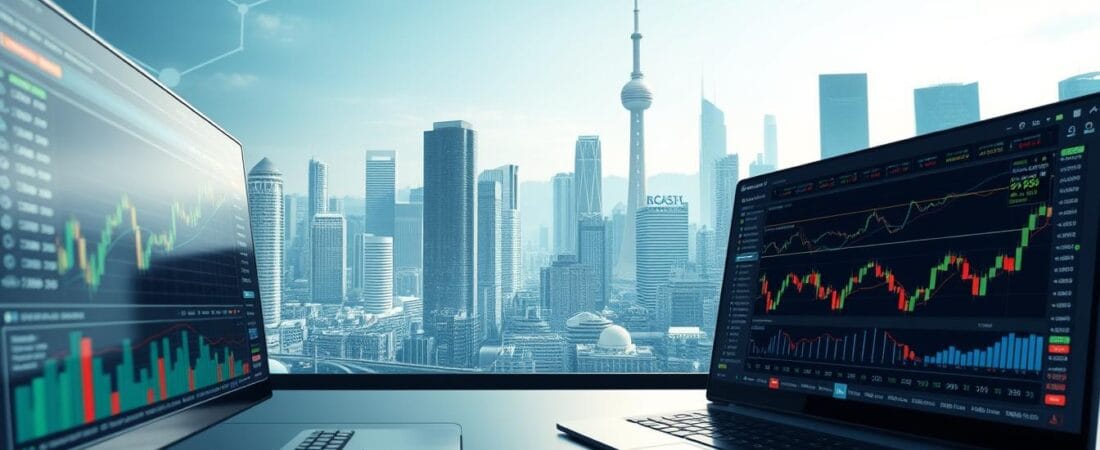In early 2025, concerns over inflation have led investors to increasingly buy crude oil futures as a hedge against potential global inflation. This trend underscores the growing importance of commodity diversification in volatile markets1. As markets evolve, understanding how to leverage futures, CFDs, and ETFs becomes crucial for building a resilient portfolio.
Investors are turning to platforms like Interactive Brokers, NinjaTrader, E*TRADE, and TradeStation for their advanced tools and market access. These platforms cater to diverse needs, from comprehensive global markets to specialized futures and forex trading2. Energy commodities like crude oil and natural gas, along with precious metals such as gold and silver, remain key portfolio stabilizers, especially during market volatility3.
Choosing the right platform involves evaluating fees, mobile accessibility, charting tools, and market range. Whether you’re a novice or an experienced trader, these factors ensure your investment aligns with your goals.
Key Takeaways
- Commodity diversification is essential in volatile 2025 markets.
- Futures, CFDs, and ETFs are integral to modern trading strategies.
- Top platforms include Interactive Brokers, NinjaTrader, E*TRADE, and TradeStation.
- Energy commodities and precious metals stabilize portfolios during uncertainty.
- Evaluate platforms based on fees, tools, and market access.
Why Commodity Trading is Essential for Diversification in 2025

As 2025 unfolds, geopolitical tensions and energy transitions are reshaping global markets. This volatility has made commodities a critical component of a diversified portfolio. Investors are turning to assets like gold and oil to hedge against uncertainty and inflation.
Gold, for instance, has shown remarkable resilience, with an 18% year-to-date performance as a hedge against inflation. Its stability makes it a preferred choice during times of economic instability. Similarly, crude oil remains highly sensitive to OPEC+ decisions and the pace of renewable energy adoption, making it a dynamic asset for traders.
For retail traders, CFDs and futures contracts offer flexibility without the need for physical ownership. These instruments allow speculation on price movements of metals, energy, and other assets. Institutional investors have also increased their allocations to commodities, with 67% adopting derivatives for risk mitigation.
“Commodities provide a unique opportunity to diversify and protect against market volatility,” says a leading financial analyst.
Whether through physical ownership or derivatives, trading in commodities offers a strategic way to navigate the complexities of 2025 markets. By understanding the interplay of geopolitical factors and energy transitions, investors can make informed decisions to stabilize their portfolios.
What to Look for in a Commodity Trading Platform

Selecting the right platform for trading requires careful evaluation of key features. Investors should prioritize fees, tools, and access to ensure the platform aligns with their goals. Understanding these factors can significantly enhance your trading experience.
Commission structures vary widely across platforms. For example, Interactive Brokers offers tiered commissions starting at $0.25 per contract, while E*TRADE charges a flat rate of $1.50. These differences can impact overall costs, especially for frequent traders.
Margin requirements are another critical factor. NinjaTrader requires a $50 intraday margin, whereas TradeStation charges $1.50 per contract. These variations can affect your account management and risk strategies.
Advanced tools like backtesting, OCO orders, and real-time chart overlays are essential for effective trading. Platforms with MetaTrader integration allow for automated trading algorithms, which can streamline your strategies.
“Choosing a regulated broker with segregated accounts ensures your investments are secure,” says a financial expert.
Educational resources also play a vital role. E*TRADE offers trading simulations, while TradeStation provides webinars. These resources can help both novice and experienced investors refine their skills.
For those starting their journey, beginner-friendly apps can be a great way to learn the basics. By evaluating these factors, you can select a platform that meets your needs and enhances your trading outcomes.
Interactive Brokers: Best for Professional Futures Traders

With over four decades of experience, Interactive Brokers offers unparalleled access to global markets. Known for its innovation in derivatives, the platform has become a go-to for professional traders seeking advanced tools and competitive pricing.
Overview of Interactive Brokers
Interactive Brokers has a 45-year history as a leader in the futures industry. It provides access to 120+ global markets, making it a versatile choice for traders. The platform’s adaptive price execution algorithms ensure competitive prices for contracts.
Key Features and Tools
The Trader Workstation (TWS) is a standout feature, supporting Python-based strategy automation. This allows users to create custom algorithms for trading. Backtesting and volatility scanning tools further enhance decision-making.
Interactive Brokers offers two account types: IBKR Pro and Lite. The Pro account features tiered commissions starting at $0.25 per contract, while Lite charges a flat rate of $0.85. Volume discounts are available for traders exceeding 1,000 contracts annually.
Pros and Cons
Pros:
– $0 account minimum, making it accessible for all levels.
– Advanced tools like TWS and Python integration.
– Competitive margin requirements, starting at $50 intraday.
Cons:
– Overnight position fees can add up for long-term traders.
– The platform’s complexity may be overwhelming for beginners.
“Interactive Brokers provides a robust solution for professional traders, combining advanced tools with global market access,” says a financial expert.
For those new to trading, beginner-friendly apps can help build foundational skills. Interactive Brokers remains a top choice for those seeking a comprehensive platform for futures and other derivatives.
NinjaTrader: Best for Dedicated Futures Traders

NinjaTrader has established itself as a leader in futures-focused platforms over the past two decades. Specializing exclusively in futures, it provides advanced tools and features tailored for experienced traders. With a commitment to innovation, NinjaTrader has become a go-to choice for those seeking precision and flexibility in their trading strategies.
Overview of NinjaTrader
Since its inception, NinjaTrader has focused on delivering a seamless experience for futures traders. The platform offers customizable heatmaps and a DOM trader for micro contracts, making it ideal for both beginners and professionals. Its free simulated trading feature, powered by real-time CME Group data feeds, allows users to practice without risk.
Key Features and Tools
NinjaTrader’s charting capabilities are a standout feature. Traders can analyze prices for assets like WTI crude and gold metals with precision. The platform also supports advanced order types, including stop-loss and OCO orders, ensuring efficient risk management.
The mobile app syncs seamlessly with the desktop version, enabling traders to manage their accounts on the go. This feature is particularly useful for monitoring energy markets and adjusting strategies in real-time.
Pros and Cons
Pros:
– Zero account opening costs and competitive pricing tiers.
– Lifetime license option for $1,499, offering long-term value.
– Advanced charting and analysis tools for futures traders.
Cons:
– No direct stock or options trading capabilities.
– The platform’s complexity may require a learning curve for beginners.
“NinjaTrader’s dedication to futures trading makes it a powerful tool for professionals seeking precision and flexibility,” says a financial expert.
For those exploring apps to enhance their trading experience, NinjaTrader’s mobile integration ensures you stay connected to the markets at all times. Its focus on futures and advanced tools makes it a top choice for dedicated traders.
E*TRADE: Best for Futures Education

E*TRADE has emerged as a leading platform for futures education, offering a blend of resources and tools tailored for investors. Its acquisition by Morgan Stanley has further enhanced its educational offerings, making it a standout choice for those looking to expand their knowledge in futures and other commodities.
Overview of E*TRADE
E*TRADE provides a comprehensive suite of educational materials, including the “Five Reasons to Trade Futures” guide. This resource is particularly valuable for beginners, offering insights into the benefits and risks of futures trading. The platform also supports IRA-compatible accounts, catering to long-term investors looking to diversify their portfolio.
Key Features and Tools
The integrated Power E*TRADE platform offers advanced tools like volatility analysis and real-time data. These features enable users to make informed decisions in the market. Additionally, E*TRADE provides free CME data for non-professionals, making it accessible for a broader audience.
Educational webinars are another highlight, offering in-depth tutorials on trading strategies. These resources are particularly useful for those new to futures, providing a hands-on learning experience.
Pros and Cons
Pros:
– Extensive educational resources, including guides and webinars.
– IRA-compatible accounts with a $25k minimum for futures trading compliance.
– Free CME data for non-professionals.
Cons:
– Limited access to international commodities markets.
– Higher fees compared to specialized platforms, at $1.50 per contract.
“E*TRADE’s focus on education makes it an excellent choice for investors looking to build their futures trading knowledge,” says a financial expert.
For those exploring trading further, automated portfolio management can be a valuable tool. E*TRADE’s combination of education and advanced tools ensures it remains a top choice for investors at all levels.
TradeStation: Best for Desktop Futures Trading
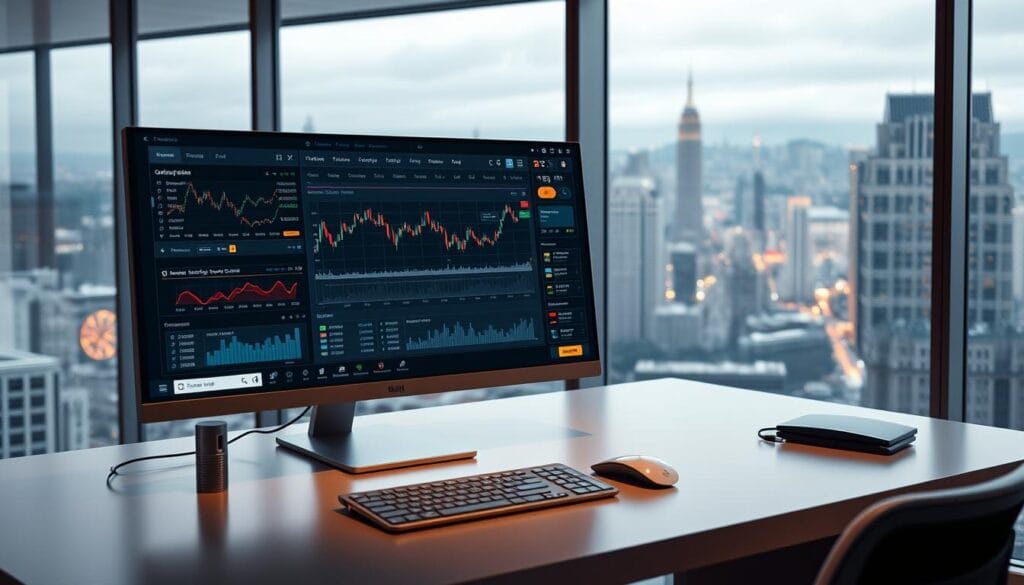
TradeStation has built a reputation as a reliable desktop platform for futures trading over the past four decades. Known for its robust tools and institutional-grade features, it caters to both active and professional traders. With a focus on desktop functionality, TradeStation offers a seamless experience for those who prefer in-depth analysis and precise execution.
Overview of TradeStation
TradeStation’s desktop platform is designed for traders who demand advanced tools and real-time data. It supports futures, options, and stock trading, making it a versatile choice for diversified portfolios. The platform’s MultiCharts integration provides institutional-grade analytics, enabling users to backtest strategies with high accuracy.
Key Features and Tools
One of TradeStation’s standout features is its Strategy Studio, which offers precise backtesting metrics for futures and etfs. Traders can analyze historical data to refine their strategies and improve decision-making. The platform also supports crypto futures, allowing users to trade digital assets alongside traditional commodities.
Free non-professional data feeds across six asset classes add significant value for active traders. This feature reduces costs and provides access to real-time market information without additional fees.
Pros and Cons
Pros:
– Advanced charting and analysis tools for precise trading.
– Free data feeds for non-professionals, reducing operational costs.
– MultiCharts integration for institutional-grade analytics.
Cons:
– Customer service response times can lag compared to competitors like Interactive Brokers.
– The desktop-centric approach may limit accessibility for mobile-focused traders.
“TradeStation’s desktop platform combines advanced tools with real-time data, making it a top choice for serious futures traders,” says a financial expert.
For those seeking a comprehensive platform with robust features, TradeStation remains a leading option. Its focus on desktop functionality and advanced tools ensures it meets the needs of active and professional traders alike.
Comparing Fees and Commissions Across Platforms
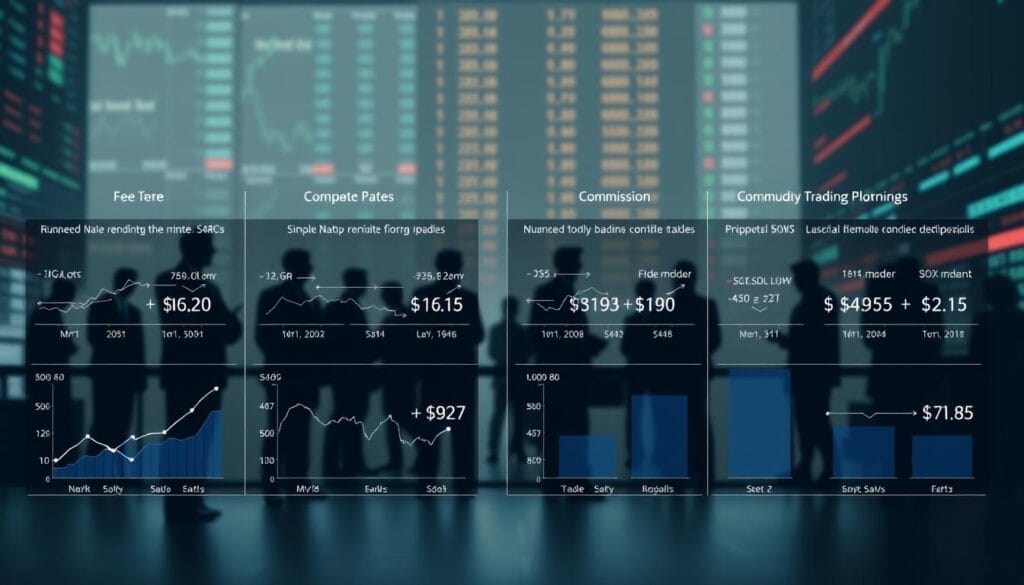
Understanding the fee structures of various platforms is crucial for optimizing your investment strategy. Different platforms charge varying rates for contracts, which can significantly impact your overall costs. For instance, Interactive Brokers offers tiered commissions starting at $0.25 per contract, while E*TRADE charges a flat rate of $1.50.
NinjaTrader provides a range of $0.09 to $1.29 per contract, making it a cost-effective option for active traders. TradeStation, on the other hand, charges between $0.50 and $1.50 per contract. These differences highlight the importance of evaluating fees based on your trading frequency and volume.
Volume discounts can further reduce costs. Interactive Brokers offers tiered pricing, which benefits high-frequency traders. NinjaTrader’s lifetime license option, priced at $1,499, can be a long-term money-saving strategy for dedicated traders.
Hidden costs like NFA fees, data subscriptions, and margin interest should also be considered. These can add up, especially for traders who rely on real-time data and leverage. Calculating breakeven points is essential to determine the most cost-effective platform for your needs.
CFDs and futures also differ in their price structures. For example, AvaTrade’s 29-pip spread on gold CFDs contrasts with the fixed commissions of futures contracts. Understanding these differences can help you choose the right instrument for your trading strategy.
“Evaluating fees and commissions is a critical step in selecting the right platform for your trading needs,” says a financial expert.
By comparing fees, discounts, and hidden costs, you can make an informed decision that aligns with your account size and trading style. This analysis ensures you maximize your returns while minimizing unnecessary expenses.
Advanced Tools and Features for Commodity Traders
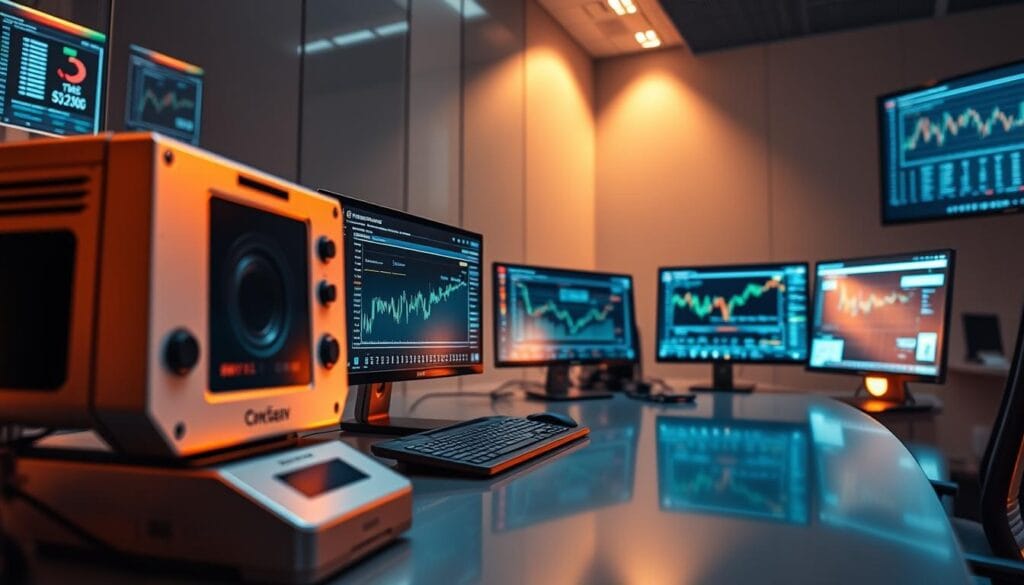
Advanced tools are reshaping how traders approach the markets in 2025. Platforms like Interactive Brokers, NinjaTrader, and TradeStation are integrating cutting-edge features to enhance efficiency and precision. These innovations are essential for navigating volatile markets and optimizing strategies.
Interactive Brokers’ API supports Python and R for algorithmic trading, enabling users to create custom strategies. This level of automation is particularly valuable for institutional traders who require high-speed execution and advanced analysis.
NinjaTrader’s ATM strategies automate entry and exit points, reducing risk and improving accuracy. TradeStation’s RadarScreen provides real-time correlations across commodities, offering a comprehensive view of the market.
Backtesting engines are another critical feature. Platforms with historical accuracy metrics allow traders to refine strategies based on past data. AI-driven price prediction plugins are also gaining traction, offering insights into future price movements.
“The integration of advanced tools is transforming the way traders analyze and execute strategies,” says a financial expert.
Volatility scanners and API access levels vary across platforms. These features are crucial for traders who rely on real-time data and third-party integrations like TradingView. By leveraging these tools, traders can stay ahead in a competitive market.
Accessibility and Mobile Trading Options
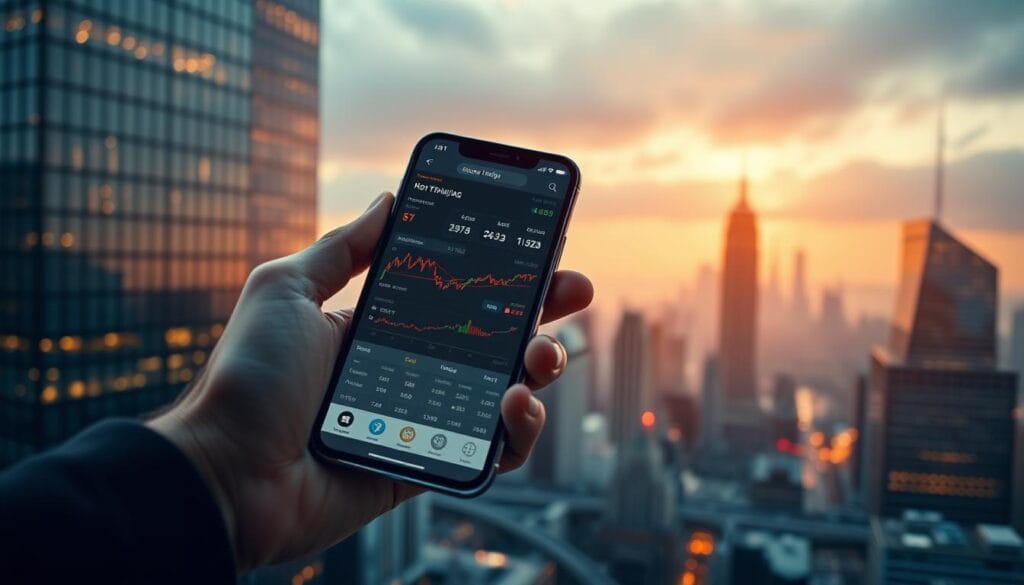
Mobile trading has become a cornerstone of modern investment strategies, offering flexibility and real-time access to markets. Platforms like NinjaTrader, E*TRADE, and Interactive Brokers have developed robust apps to meet this demand.
NinjaTrader’s 2023 cloud-based mobile platform provides seamless synchronization with desktop accounts. E*TRADE’s Power Mobile app enhances security with touch ID login, while Interactive Brokers’ iBroker Mobile offers conditional order capabilities for precise execution.
Comparing iOS and Android app ratings reveals differences in user experience. NinjaTrader scores higher on Google Play, while E*TRADE leads on the App Store. TradeStation’s mobile charting tools are praised for their accuracy, though NinjaTrader’s heatmaps offer a unique advantage.
Mobile trading has limitations, particularly in futures. Desktop platforms provide more advanced tools and real-time data, making them preferable for complex strategies. However, mobile apps excel in convenience and quick access to market updates.
E*TRADE’s mobile educational video library is a standout feature, offering tutorials on futures and other instruments. Push notification speeds for margin calls vary across platforms, with Interactive Brokers leading in response time.
“Mobile trading platforms are transforming how investors interact with the markets, offering unparalleled flexibility and access,” says a financial expert.
For those seeking a reliable mobile solution, the iBroker mobile trading platform provides live data, position management, and price alerts. Its integration with desktop platforms ensures a seamless trading experience.
As mobile trading continues to evolve, these apps are becoming essential tools for investors. By leveraging their features, traders can stay connected to the market and make informed decisions on the go.
Customer Support and Educational Resources

Effective customer support and educational resources are critical for traders navigating the complexities of modern markets. Platforms like NinjaTrader, E*TRADE, and TradeStation offer diverse support channels and learning tools to enhance the trading experience.
NinjaTrader provides 24/5 phone support, ensuring traders can resolve issues promptly. E*TRADE stands out with dedicated futures trading specialists, offering personalized assistance for complex queries. TradeStation, on the other hand, maintains a 45-minute average email response time, balancing efficiency with thoroughness.
Support channels vary across platforms. Chat, phone, and social media options cater to different preferences. E*TRADE’s “Futures 101” course is a standout educational resource, providing a structured introduction to futures trading. Interactive Brokers offers multilingual support, ensuring accessibility for global investors.
TradeStation’s paid premium support tiers provide additional benefits, such as faster response times and priority assistance. Comparing these offerings helps traders choose the right platform for their needs.
“Access to reliable support and educational materials can significantly enhance a trader’s confidence and success in the market,” says a financial expert.
Educational depth varies across platforms. While some rely on in-house courses, others integrate third-party content like YouTube tutorials. Evaluating these resources ensures traders gain the knowledge needed to manage their accounts effectively.
By prioritizing customer support and education, traders can save time and money while navigating the dynamic market. These resources are essential for both novice and experienced investors.
Market Access and Range of Tradable Commodities

The diversity of tradable assets is a key factor for traders seeking to diversify their portfolios in 2025. Platforms like Interactive Brokers, NinjaTrader, and E*TRADE offer varying levels of market access and asset range, catering to different investment strategies.
Interactive Brokers provides access to 120+ global markets, including niche assets like EU carbon credits. This extensive range makes it a top choice for traders looking to explore diverse commodities such as crude oil, gold, and silver.
NinjaTrader specializes in futures, offering over 500 contracts via CME/CBOT. Its focus on metals and energy markets, including WTI crude and COMEX gold, provides traders with precise tools for analyzing price movements.
E*TRADE, while limited to US-based commodities, offers ETF alternatives for traders seeking exposure to energy and metals without direct futures contracts. This approach simplifies access for beginners while maintaining portfolio diversity.
CFD availability varies across platforms. AvaTrade offers 60+ commodities, while Plus500 provides 30+. These differences highlight the importance of evaluating range and access when selecting a platform.
Niche markets like ethanol futures and cobalt CFDs are gaining traction. Traders can also explore cryptocurrency futures, which are increasingly available on platforms like TradeStation. These options provide unique opportunities for diversification.
Understanding the correlation between physical and derivative markets is crucial. For example, crude oil prices in Asia LNG markets often influence global energy trends. This insight helps traders make informed decisions.
“The ability to access diverse markets and commodities is essential for building a resilient portfolio in 2025,” says a financial expert.
For those exploring commodities further, precious metals and energy assets offer stable investment options. By evaluating market access and asset range, traders can optimize their strategies for success.
Risk Management Tools for Commodity Traders

Effective risk management is a cornerstone of successful trading strategies in volatile markets. Traders rely on advanced tools to mitigate potential losses and optimize their portfolio performance. Platforms like Interactive Brokers, NinjaTrader, and TradeStation offer specialized features tailored for managing risk effectively.
Interactive Brokers’ Volatility Lab provides over 25 risk metrics, enabling traders to analyze price fluctuations and adjust strategies accordingly. NinjaTrader’s built-in margin requirement calculator ensures traders maintain adequate account balances, reducing the likelihood of margin calls. TradeStation’s conditional OCO (One Cancels the Other) brackets allow for precise execution of stop-loss and take-profit orders, minimizing potential losses.
Stop-loss customization varies across platforms, offering flexibility for different trading styles. Value-at-Risk (VaR) modeling tools are also gaining popularity, providing insights into potential losses under various market conditions. These tools are essential for traders looking to safeguard their assets during periods of uncertainty.
Margin call prevention systems are another critical feature. Platforms like NinjaTrader offer real-time alerts, ensuring traders can act swiftly to avoid liquidation. Portfolio stress-test simulations help traders evaluate the resilience of their portfolio under extreme market scenarios.
“Understanding and utilizing risk management tools is essential for navigating volatile markets and protecting investments,” says a financial expert.
Insurance coverage options, such as SIPC vs. Lloyd’s, provide additional security for traders. Evaluating these types of protection ensures traders can recover from unforeseen events. For those exploring advanced strategies, AI-driven robo-advisors can enhance decision-making and analysis.
By leveraging these tools, traders can effectively manage risk and optimize their trading outcomes. The integration of advanced features ensures traders stay ahead in a competitive market environment.
User Experience and Platform Usability
The user experience of a platform significantly impacts its effectiveness and appeal to investors. A well-designed interface can enhance trading efficiency, while poor usability can lead to frustration and errors. Platforms like TradeStation, Interactive Brokers, and NinjaTrader each offer unique approaches to usability, catering to different levels of expertise.
TradeStation stands out with its 42% faster order execution compared to the industry average. This speed is crucial for traders who rely on real-time data to make quick decisions. Interactive Brokers, on the other hand, requires over 15 hours of learning for new users to master its Trader Workstation (TWS), making it more suitable for experienced traders.
NinjaTrader has earned a 4.7/5 ease-of-use rating on Trustpilot, reflecting its intuitive design. Its customizable heatmaps and DOM trader are particularly praised for their simplicity and effectiveness. These features make it a favorite among both beginners and professionals.
UI customization is another critical factor. Platforms that allow users to tailor their workspace to their specific needs can significantly enhance the trading experience. Multi-monitor setups, for example, are essential for traders who need to monitor multiple charts and data streams simultaneously.
Third-party UX studies, such as those conducted by the Baymard Institute, highlight the importance of responsive design and performance speed. These studies emphasize that a seamless user experience can directly impact trading performance. For more insights on intuitive design, visit this comprehensive review.
Beginner vs. expert mode toggles are also becoming increasingly common. These tools allow users to switch between simplified and advanced interfaces, catering to their skill level. This flexibility ensures that both novice and experienced traders can optimize their time and resources effectively.
“A platform’s usability can make or break a trader’s success. Intuitive design and responsive performance are non-negotiable in today’s fast-paced markets,” says a financial expert.
For those looking to enhance their trading experience, cashback and rewards apps can provide additional benefits. By prioritizing usability and customization, traders can ensure they are equipped with the tools needed to succeed in the competitive world of trading.
How to Get Started with Commodity Trading in 2025
Starting your journey in commodity trading in 2025 requires careful planning and the right tools. The first step is setting up your account, which varies across platforms. Some, like Interactive Brokers, require no minimum deposit, while others, such as NinjaTrader, may ask for up to $1,499.
Understanding KYC (Know Your Customer) documentation is crucial. This process ensures compliance with regulatory standards and protects your account from fraudulent activities. Be prepared to provide identification and proof of address.
Initial capital allocation is another critical factor. FINRA requires a $25k minimum for pattern day trading, but beginners can start with smaller amounts. Demo accounts are available on all reviewed platforms, allowing you to practice without risking real money.
Paper trading has its limitations. While it helps you understand the mechanics of trading, it doesn’t fully replicate the emotional and financial pressures of real commodities markets. Use it as a learning tool, but be aware of its constraints.
Common beginner mistakes include over-leveraging and failing to manage risk. Always set stop-loss orders and avoid putting all your money into a single contract. Diversifying your portfolio can help mitigate potential losses.
“Patience and discipline are key to successful trading. Start small, learn continuously, and always manage your risk,” advises a financial expert.
By following these steps, you can navigate the complexities of commodity trading in 2025. Whether you’re focusing on futures or other instruments, a well-planned approach will enhance your chances of success.
Conclusion: Choosing the Best Commodity Trading Platform for Your Needs
As the financial landscape evolves in 2025, selecting the right platform for managing your investments becomes increasingly critical. Key factors like fees, advanced tools, and market access should guide your decision. For professionals, Interactive Brokers offers unmatched global reach, while NinjaTrader excels in futures specialization.
Emerging trends, such as DeFi commodity derivatives and AI integration, are reshaping the market. Traders should consider these innovations when building their portfolio to stay ahead. Matching your account needs with the right platform ensures optimal performance and growth.
For those starting their journey, platforms with educational resources and demo accounts are ideal. As you gain experience, upgrading to more advanced systems can enhance your strategies. Explore effective trading strategies to further refine your approach.
Ultimately, understanding your risk tolerance and aligning it with the right platform is key to success in 2025’s dynamic markets.
FAQ
Why is commodity trading important for diversification?
What features should I look for in a trading platform?
How do Interactive Brokers stand out for futures trading?
What makes NinjaTrader unique for futures traders?
Is E*TRADE suitable for beginners in futures trading?
What are the advantages of TradeStation for desktop trading?
How do fees compare across different platforms?
What advanced tools are available for commodity traders?
Are mobile trading options available for commodity traders?
What educational resources are available for new traders?
What commodities can I trade on these platforms?
How do risk management tools help commodity traders?
How important is platform usability for traders?
How can I start commodity trading in 2025?
Source Links
- https://www.reuters.com/business/energy/renewed-inflation-worries-help-drive-oil-price-rally-2025-01-27/
- https://www.investopedia.com/interactive-brokers-vs-e-trade-4587948
- https://www.reuters.com/markets/commodities/cocoa-tops-global-commodities-rally-for-2nd-year-steel-ingredients-struggle-on-china-demand-2024-12-31/

